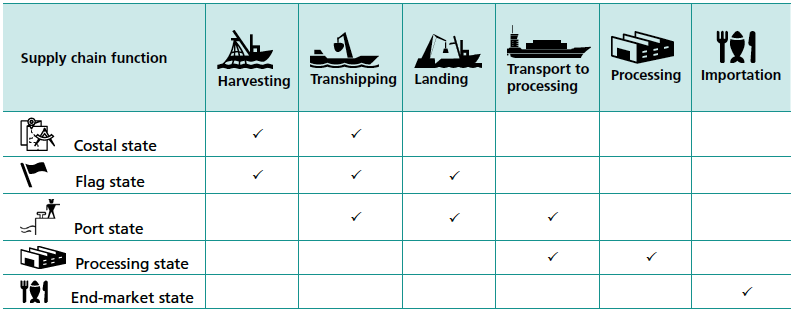I promised that I would slowly digest and post parts of our CDS publication to bring some of the key elements to the table, here is the 2nd post.
Standardised supply chain: CTEs and State control
One of key issues we found when talking about CDS is a limited understanding of the “roles” of each type of state in the CDS picture in particular, but also in the MCS in general. Since country-specific mechanisms are often essential for verifying and corroborating submitted data, enhancing monitoring functions and identifying and sanctioning fraudulent transactions. (And is also a good proxy on why a "single country CDS" would hardly ever have a substantial impact on multi-state value chains)
The state types involved in fishing, landing, processing and trade of fisheries products along the supply chain are “fixed” and each type of state carries out functions that contribute to the success of the CDS:
Flag state. This is the state whose flag is flown by fishing vessels, whose activities it is obliged to authorize and to monitor under international law. In international fisheries targeting species under the management of an RFMO, flag states also have reporting obligations to the international body as to the activities and catches of their fleet(s). Oversight by the flag state covers harvesting, transhipment and landing operations, the latter typically regarded as the last transaction related to fishing. The flag state is crucial in a CDS in that it validates catch certificates for catches harvested during fishing trips deemed by the flag state to have been conducted legally.
Coastal state. This is the state in whose waters a fishing operation may be taking place, in which case the coastal state must provide the necessary oversight to ensure that foreign vessels entering its waters are authorized to operate, and report operations and catches to relevant coastal state authorities. Coastal states currently have no statutory role in existing unilateral and multilateral CDS.
Port state. This is the state in whose port(s) fish are landed. The port state has a legal obligation under the PSMA to ensure that only legal fish are landed by carrying out rigorous in-port inspections of vessels flying a flag other than that of the port state and voluntarily entering its ports to land fish. The port state is crucial in ensuring that catch to be landed from a CDS-managed fishery are covered by valid catch certificates at the time of landing.
Processing state. This is the state in which raw products are converted into semiprocessed products or end products. The processing state may be the same as the port state, but fisheries products for processing may enter the processing state by sea, air or land. Processing states are important in CDS systems in terms of ensuring that non-certified fishery products are not imported, processed or certified for export or re-export. The “laundering” of fisheries products into legally certified supply streams occurs mostly at this level.
End-market state. This is the territory in which final consumer products are placed on the market, acquired by customers and consumed, often after importation. In a CDS the action of the end-market state is limited to ensuring that non-certified products cannot gain access to its consumer markets – a crucial final element in guaranteeing the success of a CDS.
The illustration above shows a standardized supply chain with the segments covered or controlled by the various state types. It is clear that few operations or CTEs (Critical Tracking Events) along the supply chain are under the exclusive purview of a single state type and that a large number of operations fall under the purview of different state types along the supply chain. The flag state, for example, will (or at least should!) oversee transhipments and landings, but so will the port state when these do take place in a port, and sometimes the coastal state is involved in oversight of transhipments in its EEZ.
Yet is really important to understand, that a single country can act as a few or as all of the state types at once, and at different levels of involvement.
In the Tuna world, a country like PNG for example, is at once a important flag, coastal, port and processing state, and in a lesser level a market state. Countries like Nauru or Tukelau are only coastal states, Thailand is the ultimate example of a processing state, Taiwan and China (even if it brings some fish back to its ports) are examples of major flag states, finally the EU and the US, that dependes substantially on imports, are major End-Market States, even if they have their own fleet, ports and processors.
This multiplicity of roles is important, since from the seafood traded internationally; 61% originates in developing countries and 85% of it is destined for developed countries. The current internationally integrated seafood value chains show that for most products many different administrations may be involved from catch to consumer.
